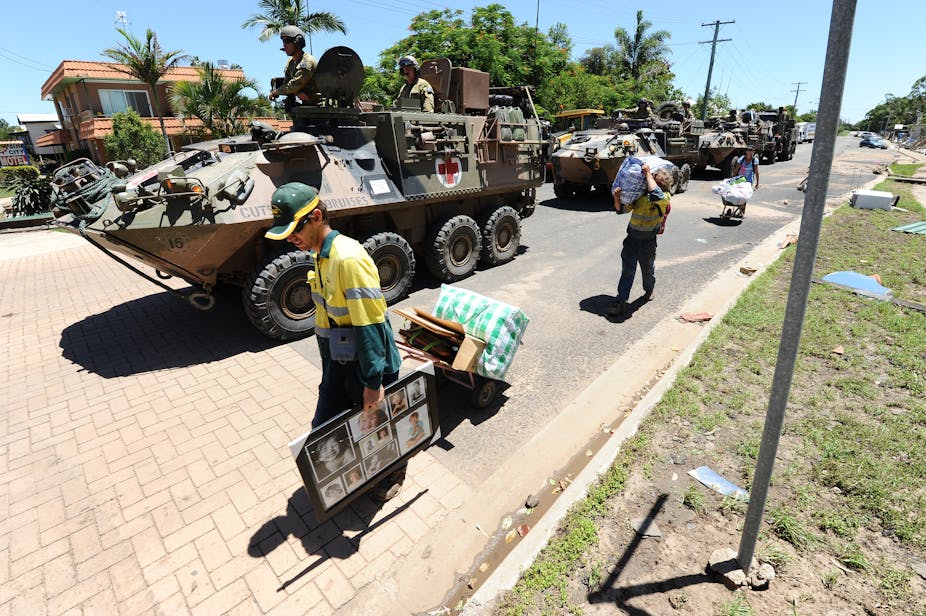Following several years of devastation in Queensland, the state’s premier believes it’s time to “flood and disaster proof” as many towns and communities as possible. In Mr Newman’s words: “We can’t accept that’s how life has to be lived.” But climate change throws us into a world where the unacceptable may become unavoidable. So where do you start?
Research at the National Climate Change Adaptation Research Facility (NCCARF) is considering how to reduce the negative impacts of climate. In research parlance, this is known as adaptation. We have looked at past natural hazards and their disastrous outcomes to consider lessons for future adaptation.
A holistic and pragmatic approach
History does repeat. Even where there are adaptations to reduce disaster impacts, subsequent disasters can bring new challenges. Charleville, for example, is protected from river floods by a levee but in 2008 flash flooding from the town’s gully was not prevented by the levee.
Adaptation planning must consider all risks. There is no point taking an action to reduce the impact of one disaster type, if it exposes a community to worsened impacts of another. How does a house built to withstand high wind speeds behave in a heatwave or a fire, for example? So reducing disaster impacts (adaptation) is a complex decision-making process.
It may also call for several solutions – plus ongoing review and tweaking as new knowledge arises or circumstances change. Consider the Mississippi River in the US. Ongoing floodplain development has meant regular disastrous flood events. Each time these are responded to with higher and more levees, which are then over-topped or breached in the next floods.
With repeated disasters, significant investment and on-going financial loss, new approaches may be needed and some communities and governments may eventually have to face the reality that the risk is too high and relocation may be the only viable option.
Adaptations after disasters may include social change (such as preparation, planning and information) and hard solutions (such as infrastructure change, sea walls). Much of Australia’s current disaster management philosophy has a strong emphasis on building resilience long before a natural hazard occurs. We like to ensure communities are aware of risks and prepared to respond (see, for example, bushfire plans).
Cost-benefit-risk
Adaptation is costly, but the long-term costs of failing to adapt (such as on-going flood damage) may out-weigh these costs and vice versa. The Netherlands invested €9 billion in building flood defences to avoid a 1-in-10,000-year event following the deadly 1956 storm-surge. They are presently exploring far-future sea-level rise (up to 5m) at a cost of over €80 billion.
The government took a pragmatic approach to building a business case for adaptation investment. What price to prevent a repeat tragedy? For any government contemplating adapting to natural disasters there should always be an exercise in comparing acceptable risk and cost.
For Queensland, the cost of the flood disasters to government coffers since 2011 is in the order of $15 billion. If we are unwilling to face the same risk again, what will adaptation cost and how does it compare to the damage bill?
Consider a proposed flood levee for Roma costed at $20 million. Compared to an estimated $10 million spent on helicopter rescues alone during the 2011 floods - the argument to invest seems compelling. But the initial capital outlay in a time of fiscal restraint and conservancy will take an incredible amount of political (and public) will for an unquantifiable future risk. The acceptable risk threshold will have to be balanced against the willingness to bear costs.
If adaptation planning happens now, then disasters can be an opportunity to implement them. The Queensland Reconstruction Authority, overseeing the 2011 floods and cyclone recovery, undertook to “build back better”. Reconstruction was to current engineering standards as a minimum (which in some cases improved structural resilience), and where it “made sense” improvement of the rebuilt structure. There is considerable room to expand this policy.
Success and pitfalls
Adaptation following a disaster can be highly successful. After Cyclone Tracy, a methodical effort ensured houses are now designed to withstand the worst events rather than day-to-day weather. Houses built to these standards have proved much safer during recent cyclones.
“Disaster-proofing” means anticipating the worst possible scenario. Even without figuring in climate change, how do we ever know that we have experienced the worst record-breaking disaster? If a community believes its defences will hold – what catastrophe could be unleashed if they fail? This false sense of security could be called “perverse resilience”. Despite the level of investment, the Netherlands are now diversifying from pure-engineering solutions in the realisation that a lot was riding on engineering defences withstanding the worst. If a government gets it wrong, the liability could be phenomenal.
Queensland has already invested in an adaptation strategy, and adaptation research, including with NCCARF. The critical step now is to ensure the momentum of the disaster response translates into long-term planning and investment - but perhaps towards a resilient, well-adapted Queensland rather than a “disaster-proofed” one.

